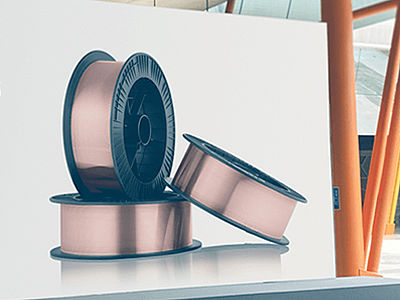EDM FAQ - frequently asked questions
Answers to frequently asked questions about brazing & welding
Are you looking for quick & easy answers to frequently asked questions about brazing & welding? Then our bedra FAQ is the right place for you. If the answers given here are not enough for you, you can contact us at any time.
General questions
What is the difference between brazing and welding?
Welding and brazing differ as follows:
Welding:
Welding involves joining metal parts by melting the base materials. This usually takes place at very high temperatures. Welding creates a permanent, strong bond between the parts. There are various welding techniques, including arc welding, gas welding and resistance welding, which can be used depending on the materials to be joined and the specific requirements of the application. Welding is often used in constructions where a strong, structural connection is required, such as in the construction of bridges, buildings, ships or in the manufacture of vehicles.
Brazing:
Brazing involves joining metal parts by melting an additional metal material (solder paste or solder wire) that has a lower melting temperature than the base materials. The base material is not melted in the process. Soldering creates a connection between the parts that is less strong than welding. However, it is often sufficient for applications where mechanical strength is not a priority. There are different soldering techniques, including soft soldering and brazing, which can be used depending on the materials to be joined and the specific requirements. Soldering is often used for electronic applications, such as joining PCB components, or for the manufacture of jewelry and fine mechanical parts. To summarize, welding creates a strong, structural joint, while brazing creates a joint with less strength, but sufficient for many applications, especially those requiring electrical or fine mechanical properties.
When is brazing used and when is welding used?
Brazing is used for joining galvanized sheet metal, whereas welding is used for joining low-alloy steels.
What is the difference between MIG/MAG brazing or welding and TIG welding?
MIG/MAG welding describes MIG welding (metal inert gas welding) with active shielding gases (pure CO2, gas mixtures of argon, carbon dioxide, oxygen or a combination of these), whereas MIG welding is welding with inactive shielding gases (pure argon or mixtures of argon and helium). The inactive gas (also known as inert gas) does not react with the base and filler materials, whereas the active gas has an active influence on the arc and the welding process.
MIG brazing is a brazing process that is carried out using MIG/MAG or pulse arc gas-shielded welding equipment. The heat output required for the brazing process is generated by the arc. MIG soldering is used for joining galvanized sheet metal, among other things. The base material is not melted, but a brazed joint is created between the workpieces. In contrast to welding, the galvanized surface is not damaged and continues to provide corrosion protection. MIG brazing is also used for joining high-strength sheet metal, as the microstructure is less altered by the lower heat input than would be the case with welding.
TIG welding stands for tungsten inert gas welding and is a welding process from the group of arc welding under a shielding gas atmosphere. The shielding gases used are pure argon, argon-helium or argon-hydrogen mixtures. In TIG welding, the welding arc burns between a non-consumable electrode made of pure or alloyed tungsten and the base material. TIG welding is carried out with direct current or alternating current and can be used for all weldable metals and for TIG soldering.
What is the difference between bercoweld® and berAlweld® brazing and welding wire?
The bercoweld® series was developed for brazing and welding copper and copper alloys. Our range of bercoweld® brazing and welding wire currently comprises more than 20 alloys.
In 2021, we expanded our portfolio of brazing wire and welding wire to include high-quality filler materials made from aluminium alloys. To do this, we have combined our experience from over 130 years in wire production with the latest technologies and specialists from the aluminium sector. As a result, we can now offer you aluminium welding wires under the name berAlweld® in the well-known high bedra quality. We currently offer our customers a berAlweld® welding wire range consisting of nine different alloys.
Which brazing and welding wire alloys does bedra offer?
bedra offers the following 6 alloy families:
- Low-alloyed copper alloys (Cu content > 95 %)
- Tin bronzes (tin content)
- aluminium bronzes (proportion of aluminium, nickel, manganese, tin, iron)
- Copper-nickel alloys (nickel content 10 or 30 %)
- Special alloys (pure copper; CuMnNi alloys)
- aluminium alloys: aluminium wires for welding applications in the main qualities Series 1000 / 4000 & 5000. For pure aluminium, Si-containing or Mn-containing base materials.
Comprehensive information on our brazing and welding wire portfolio can be found on our bedraWELDING page.
What are common welding defects? What should you pay attention to?
In the following section you will find the most common welding defects and their possible causes:
- Porosity
Possible causes of porosity:- Contamination
- Gas settings
- Moisture
- Welding machine settings
- Air movements
- Welding parameters
- Bonding errors
Possible causes of bonding errors:- Hot cracks
- Oxides
- Storage
- Transportation (cold bridges)
- Seam charred (special defect pattern when welding aluminium)n von Aluminium)
Possible cause of a charred seam::- Too much energy
What are the most common welding processes?
TIG welding
- Suitable for thin sheets from 0.5 mm
- Sometimes it is not economical to weld sheets thicker than 5.0 mm
- Suitable for difficult alloys
- It is easy to find suitable filler materials
- Suitable for alloys when you are not sure which material is the base material
- When the quality of the seam must be high (root seam)
- Suitable for repair welding of seams made using a different welding method
MIG welding
- Suitable for thin and thick sheet thicknesses
- Short-circuit arc
- Spray arc
- Welding in the spray arc is low-spatter
- When productivity and economy are an important element
- When you want to replace another welding method
PULS MIG welding
- When spatter-free welding is required
- Pulse MIG is very well suited for position welding between 1.0 - 6.0 mm sheet thickness
- When high welding quality is required
- When cost savings are important elements
- When you want to replace another welding method
- In many cases it can replace AC - TIG welding
- When a high welding speed with low energy input is required
How do I choose the right welding process?
There are many ways to join two metal parts. Therefore, the following points should be considered when choosing the right welding method:
- Composition of the base material
- heat input
- Sheet thickness
- Position of the weld
- Weld quality (appearance)
- Welding effort (productivity)
- Skill of the welder
What types of spool option do we offer?
In our spool overview, we have listed all the make-ups available from bedra. In addition to the spool illustrations, you will also find the spool dimensions and the maximum filling weight per spool.
Which spool option is right for me?
The type of spool option depends on the individual customer requirements as well as the existing system configuration. In our spool overview, we have listed all the types of packaging available from bedra. In addition to the spool illustrations, you will also find the spool dimensions and the maximum filling weight per spool.
Where can I find the current metal prices?
In our metal price information system you will find daily updated metal prices. Foreign exchange and the prices of raw metals are displayed. The metal prices are displayed either as a chart, table or monthly average.
Why are welding rods (TIG rods) embossed?
Our welding rods (TIG rods) are supplied embossed or unembossed. The embossing differs depending on the product type and requirements and can contain customer-specific data, the material number or TUV-relevant data (for berAlweld®).
Legible and correct embossing is important to avoid mix-ups and to ensure that the correct filler metal can always be assigned to the welding task. If the welding rod is halved in the middle for better handling, it should always be embossed on both sides. The welding rod is welded in such a way that the remaining piece always contains the embossing and the filler metal can still be identified after welding.
What accessories are available for brazing and welding wires?
We offer comprehensive services and complete solutions that increase our customer's efficiency. This also includes our new range of accessories for copper and aluminium applications in the field of welding and brazing. Here, together with a partner, we offer complete solutions from hoods to complex conveyor systems. In this way, we minimize wire tangles, knots and loops, thus reducing tensile force as well as abrasion, which leads to a significant increase in productivity. We currently offer the following products:
- Maxiglide: Safe wire feeding from the drum to the machine
- Twister: Prevents knots and wire tangles
- Straightener: Gives the wire the optimal caste
- Hoods
- Heavy duty drum dolly
- Lifter
What are welding rods used for?
Welding rods are used as filler metal in TIG welding. They are fed manually into the weld pool and melted by the TIG arc. Weld seam thickness and shape, the shape of the root and the scaling of the weld seam surface can be influenced by the targeted addition of the filler rod. Welding rods are suitable for the following applications:
- Welding rods are suitable for thin sheets from 0.5 mm, as it is sometimes not economical to weld sheets thicker than 5.0 mm
- Suitable for difficult alloys
- It is easier to find suitable filler materials for welding rods
- Suitable for alloys where you are not sure what the base material is made of
- When the quality of the seam must be high (root seam)
- Suitable for repair welding of seams made with a different welding method
Which metals are suitable for welding?
In principle, ferrous and non-ferrous metals can be joined by welding in the same or similar ways. TIG or MIG soldering is used to join metal and non-ferrous metal. The most common metals used for welding and brazing are:
- Unalloyed steels
- Unalloyed stainless steels
- Stainless steels
- Alloyed steels
- aluminium
- Brass
- Copper
- Nickel
- Titanium
There is an optimum welding process for every material. In general, however, the welding process determines whether a material is suitable for welding. "
Which shielding gas is used for MIG brazing?
Pure argon is usually used as the shielding gas for MIG brazing. Mixed gases with up to 2.5 percent active component, e.g. CO2 or oxygen, are advantageous for a whole range of applications.
What are typical areas of application for brazing and welding wires?
Brazing and welding wire is used in areas such as transportation technology, plant engineering and the construction industry. One focus in the field of transportation technology is in the automotive and supplier industry. Other industries include the following:
Transportation technology
- Automotive industry
- Railway track construction
- Shipbuilding
- Motorcycle industry
- Bicycle industry
- Agricultural machinery
- Defence technology
Plant construction
- Offshore / Onshore
- Turbine construction
- Mold & toolmaking
- Mining
- Container construction
Construction industry
- Building industry
- Construction machinery
What safety precautions should be taken when brazing and welding?
When brazing and welding, safety precautions are essential to avoid accidents and damage to health. Here are some important safety measures that should be observed:
- Wear protective clothing: This includes safety goggles with side shields, a welding mask or a welding helmet with a built-in filter to protect the eyes from glare, sparks, and splashes. Heat-resistant gloves and work clothing should also be worn to prevent skin burns.
- Ensure ventilation: Work in well-ventilated areas or use an extraction system to remove fumes, vapors and gases. These may contain toxic substances that are released during welding and brazing.
- Have fire extinguishers ready: Keep fire extinguishers or other suitable extinguishing equipment nearby for quick response to fires that could be caused by sparks or hot metal parts.
- Keep the workplace clean: Remove flammable materials from the vicinity of the work area to reduce the risk of fire. Keep the work area clean and tidy to avoid tripping hazards.
- Observe electrical safety: Ensure that electrical welding and brazing equipment is properly connected and grounded to minimize the risk of electric shock.
- Personal safety: Avoid touching metal parts or electrodes with bare hands, as they can be extremely hot. Also avoid direct skin contact with hot surfaces.
- Training and knowledge: For both welding and brazing, it is important to have the appropriate knowledge and skills. Proper training and experience will significantly reduce the risk of accidents.
- Emergency planning: Make sure you have an emergency plan that includes first aid and evacuation procedures in the event of an accident. All employees should be informed about the plan.
By following these safety precautions, you can significantly reduce the risk of accidents and injuries during welding and brazing.
What does "elongation" or "elongation at break" mean?
The elongation or elongation at break characterizes the deformation capacity of a material by indicating the permanent elongation of the tensile specimen after fracture in relation to the initial gauge length. The elongation at break is always given as a percentage value. The formula symbol for elongation at break is A. For round specimens, the index A5 or A10 is usually used to indicate elongation at break.
What does "tensile strength" mean?
The tensile strength is one of several strength parameters of a material and shows the maximum mechanical tensile stress that the material can withstand, including plastic deformation. If the material is stressed to the tensile strength range, it is already plastically deformed (damaged) and will not return to its original shape. The formula symbol for tensile strength is Rm. The dimension of tensile strength is the mechanical stress with the units N/mm² or MPa (megapascal).
What does "yield strength" mean?
The yield strength is the limit up to which a material can be subjected to tensile stresses without undergoing plastic deformation. The material returns to its original shape up to this limit after the tensile stress is removed. The formula symbol for the yield strength is Re. The dimension of the yield strength is the mechanical stress with the units N/mm² or MPa (megapascal).
What does "modulus of elasticity" mean?
The modulus of elasticity, also known as Young's modulus, tensile modulus, coefficient of elasticity, strain modulus or Young's modulus, characterizes the relationship between stress and strain during the deformation of a solid body with linear elastic behaviour. The formula symbol for the modulus of elasticity is E. The dimension of the modulus of elasticity is the mechanical stress with the units N/mm² or MPa (megapascal).
Copper brazing and welding wire (bercoweld®) applications
What does bercoweld® mean?
bercoweld® is the brand name of our copper-alloyed welding consumables and is short for Berkenhoff copper welding.
What are the advantages of bercoweld® brazing and welding wire compared to standard wires?
Some advantages of bercoweld® brazing and welding wire are
- High corrosion resistance
- Optimum gap bridging
- Low joining temperatures
- Lower energy requirement
- Less distortion of the base material due to low heat penetration
- No galvanizing of the joint seam required.
Expressed in figures, working with copper brazing wires results in potential savings of up to 30 percent in manufacturing costs compared to conventional steel wires. A similar balance can be drawn with regard to energy consumption. The savings potential here is up to 20 percent. Against the backdrop of rising energy prices, particularly due to the impending taxation of CO2 emissions, this area is therefore of particular importance.
As a process-autonomous company with its own foundry and downstream production, alloy and dimensional tolerances that are significantly tighter than all national and international standards can also be maintained on a sustainable basis. This results in optimum process stability during brazing and reproducibility of the brazing result.
Which copper brazing and welding wires are best suited for wear layers or functional layers?
For wear layers or functional layers, we recommend the following bercoweld® brazing and welding wires
Where are bercoweld® brazing and welding wires used?
bercoweld® brazing and welding wires are suitable for multiple applications. The most important industries are automotive, shipyards, lightweight construction, commercial vehicles and 3D printing.
What is the copper brazing and welding wire recommendation for automotive applications?
For automotive applications we recommend the following bercoweld® brazing and welding wires:
What is the copper brazing and welding wire recommendation for railroad and shipbuilding applications?
For railroad and shipbuilding applications, we recommend the following bercoweld® brazing and welding wires
Which copper brazing and welding wires are best suited for solenoid/high-pressure valves?
For solenoid/high pressure valves we recommend the following bercoweld® brazing and welding wires:
Which copper brazing and welding wires are best suited for tilting cylinders?
Which copper brazing and welding wires are best suited for sheet metal components?
For sheet metal components we recommend the following bercoweld® brazing and welding wires:
Which copper brazing and welding wires are best suited for waste systems?
For waste systems we recommend the following bercoweld® brazing and welding wires:
Which copper brazing and welding wires are best suited for control cabinets?
For switch cabinets we recommend the following bercoweld® brazing and welding wires:
Which copper brazing and welding wires are best suited for exhaust systems?
For exhaust systems, with the base material galvanized ferritic NR sheets, we recommend the following bercoweld® brazing and welding wires:
Is there a best-before date for copper brazing and welding wire?
We recommend using the wire within 6 months. A maximum use of 12 months after purchase is recommended.
Do I have to preheat certain applications when brazing or welding with copper?
If the volume of the base material is significantly larger, it should be preheated. Preheating prevents hot cracks.
What approvals does bercoweld® brazing and welding wire have?
Our bercoweld® brazing and welding wire has TUV approval.
What is the difference between bercoweld® S2 und S3?
The bercoweld® S2 wire is a specially developed material with a reduced Si content for brazing galvanized sheet metal. It flows better than bercoweld® S3 wire. The bercoweld® S3 wire is used for processing galvanized body panels in the automotive industry, coatings on low-alloy steels, solenoid valves and switch cabinets, among other things.
What makes bercoweld® S2 brazing and welding wire special?
With the bercoweld® S2 wire electrode, welding and brazing processes in automotive construction can be significantly optimized. The copper brazing wire offers even better functionalities such as optimized flow properties, better gap bridging and a higher processing speed. This filler material has been specially adapted for use with coated sheet metal for the automotive industry. Good flowing weld pool, greatly reduced tendency to pore and spatter formation are just some advantages compared to bercoweld® S3. Suitable for welding Cu and Cu alloys as well as unalloyed and low-alloy steels and cast iron. see:
How exactly does 3D printing with bercoweld® brazing and welding wire work?
3D printing, also known as additive manufacturing, offers unprecedented possibilities and great savings potential. It enables the individual and flexible production of components with completely new shapes and functionalities without any loss of material, as is the case with conventional powder or granulate manufacturing processes. All bercoweld alloys are suitable for 3D printing, especially our high-alloy aluminium bronzes:
What does "low alloy" mean in connection with copper brazing and welding wire?
Low-alloy copper alloys are copper alloys with a low content of e.g. manganese, nickel or tin. The concentration of the individual elements is usually less than 1 to 2 %, and less than 5 % in total. These copper alloys have a medium or high electrical conductivity.
Aluminum welding wire (berAlweld®) applications
What is aluminium welding wire?
Aluminium welding wire is a wire used in the welding of aluminium workpieces. It is used to join aluminium parts together by melting during welding and creating a permanent bond.
What is aluminium welding wire used for?
Aluminium welding wire is mainly used in applications where aluminium needs to be welded. This can be the case in the aerospace industry, in vehicle construction, in shipping, in the manufacture of aluminium structures and many other areas.
What properties does aluminium have?
Aluminium is a versatile metal with a variety of properties that make it suitable for a wide range of applications. Here are some of the most important properties of aluminium:
- Lightweight: Aluminium is a light metal with a density of about one-third that of steel: this makes it an ideal material for applications where light weight is required, such as transportation and aerospace.
- Corrosion resistance: Aluminium forms a thin oxide layer on its surface that protects it from corrosion. This natural oxide layer makes aluminium resistant to corrosion and makes it particularly suitable for outdoor applications or in humid environments.
- High thermal conductivity: Aluminium has excellent thermal conductivity, making it a popular material for heat exchange and cooling applications, such as in radiators, air conditioners and heat sinks for electronics.
- Good electrical conductivity: Aluminium also has good electrical conductivity and is therefore often used in electrical wires, cables and other electrical engineering applications.
- Formability: Aluminium is easy to form, cast and extrude, making it a versatile material for the manufacture of a variety of components and products.
- Recyclability: Aluminium is 100% recyclable without compromising its quality. This makes aluminium an environmentally friendly material and helps conserve natural resources.
- Gloss: Aluminium has a natural metallic sheen that makes it an attractive material for decorative applications.
These properties make aluminium an extremely useful and widely used material in many industries, including transportation, construction, electronics, packaging and many others.
What does berAlweld® mean?
berAlweld® is the brand name of our aluminium welding consumables and stands for Berkenhoff aluminium welding.
What are the advantages of berAlweld® welding wire compared to standard wires?
berAlweld® welding wire offers all the advantages needed to perform when welding aluminium alloys. You can count on superior performance of berAlweld® as our entire development expertise and know-how of our company has gone it's development. Depending on the respective product type, our aluminium brazing and welding wires are characterized by their good flow properties and increased corrosion resistance. berAlweld® impresses with its low sensitivity to hot cracks and enables bright, virtually fume-free welding. In addition, our wire solutions for aluminium alloys meet the highest demands in terms of tensile strength.
Discover berAlweld® welding wire
What approvals does berAlweld® welding wire have?
In the following section you will find the approvals of the respective berAlweld® wires:
- berAlweld® 4043: TUV, DB (Deutsche Bahn)
- berAlweld® 5087: TUV, DB (Deutsche Bahn), DNV (Det Norske Veritas)
- berAlweld® 5183: TUV, DB (Deutsche Bahn), DNV (Det Norske Veritas)
- berAlweld® 5356: TUV, DB (Deutsche Bahn), DNV (Det Norske Veritas)
Further information can be found in the berAlweld® brochure.
Where are berAlweld® welding wires used?
berAlweld® welding wires are suitable for multiple applications. The most important industries are automotive, shipyards, lightweight construction, commercial vehicles and trade.
Which aluminium welding wire is suitable for my application?
With our aluminium welding wire finder, you can quickly and easily find a suitable welding wire for your application. The only requirement: You know which standard (AWS or ISO) you have and you know the two base materials you would like to weld.
Based on the standard you have selected and the two base materials, the aluminium welding wire finder immediately determines a welding wire recommendation for you. (For certain base material combinations, there is a possibility that an additional question regarding a possible approval for shipbuilding will appear).
You then have the option of contacting us directly by requesting a quotation based on the recommendation, or requesting a callback for detailed advice.
Go to welding wire finder aluminium
Which AWS series are the most common for aluminium?
1000er series:
- Pure aluminium AWS 1050 (Al 99.5%)
- High thermal and electrical conductivity
- Excellent weldability and good weld strength 100N/m²
- 1050 (Al 99.5%) is the most commonly used alloy for welding
- Main applications: Electrical wiring and thermal components, good resistance to nitro acids
4000er series:
- (AlSi) Silicon (Si) is the main alloy content in this group
- 4043 (AlSi5) is the most common welding alloy
- Excellent weldability and good weld strength 120N/mm²
- Main applications: Automotive applications
5000er series:
- (AlMg) Magnesium (Mg) is the main alloy in this group
- 5356 (AlMg5) is the most common welding alloy
- Excellent weldability and excellent weld strength 250N/mm²
- Main application: Boat & shipbuilding, railroad wagon construction
What is the aluminium welding wire recommendation for US machines?
With our aluminium welding wire finder, you can quickly and easily find a suitable welding wire for your application. The only requirement: You know which standard (AWS or ISO) you have and you know the two base materials you would like to weld.
Based on the standard you have selected and the two base materials, the aluminium welding wire finder immediately determines a welding wire recommendation for you. (For certain base material combinations, there is a possibility that an additional question regarding a possible approval for shipbuilding will appear).
You then have the option of contacting us directly by requesting a quotation based on the recommendation, or requesting a callback for detailed advice.
Go to welding wire finder aluminium
What is the aluminium welding wire recommendation for automotive applications?
For automotive applications we recommend the following berAlweld® welding wires:
Our aluminium welding wire finder provides you with a reliable recommendation:
Go to welding wire finder aluminium
What is the aluminium welding wire recommendation for railroad and shipbuilding applications?
For railroad and shipbuilding applications we recommend the following berAlweld® welding wires:
Our aluminium welding wire finder provides you with a reliable recommendation:
Go to welding wire finder aluminium
When to use which aluminium welding wire?
With our aluminium welding wire finder, you can quickly and easily find a suitable welding wire for your application. The only requirement: You know which standard (AWS or ISO) you have and you know the two base materials you would like to weld.
Based on the standard you have selected and the two base materials, the aluminium welding wire finder immediately determines a welding wire recommendation for you. (For certain base material combinations, there is a possibility that an additional question regarding a possible approval for shipbuilding will appear).
You then have the option of contacting us directly by requesting a quotation based on the recommendation, or requesting a callback for detailed advice.
Go to welding wire finder aluminium
Which welding gases should I use for aluminium welding wire?
Inert gases such as argon (Ar), helium (He) and mixtures of Ar with He are always used for aluminium welding. Examples of this are
- Pure argon
- 75% Ar + 25% He
- 50% Ar + 50% He
- 25% Ar + 75% He
Argon is the most common shielding gas for aluminium welding. Helium and argon/helium mixtures offer additional advantages due to better penetration.
There are also multi-component gases that contain nitrogen (N) as well as argon and/or helium.
Can my berAlweld® welding wire age?
Aluminium wires are subject to an aging process, which is taken into account during production. Basically, you can say:
- The 1000 series loses approx. 30% of its pretension within 4 weeks of storage
- The 4000 series loses approx. 90% of its pre-tension in the same period
- The 5000 series loses the least pre-tension compared to the other two series, only approx. 20%.
Is there a best before date for aluminium welding wire?
We recommend using the wire within 6 months. A maximum of 12 months after purchase is recommended.
Do I need to preheat certain applications when welding with aluminium?
If the volume of the base material is significantly larger, it should be preheated. Preheating has the following main reasons:
- Drying of the material (preheating without condensation)
- Better heat conduction to prevent cracking, especially with thick sheets (>15mm)
- Preheating also helps to reduce pores in the seam
- Reduces the risk of bonding defects due to "cold spots" in the weld seam
- Better seam appearance and uniform flow onto the weld seam flanks
Can I use aluminium welding wire for different thicknesses of aluminium?
Yes, aluminium welding wire can be used for different thicknesses of aluminium. However, it is important to select the correct welding parameters and wire diameter for the specific material thickness and welding method.
Are there any special preparations that need to be carried out before welding with aluminium welding wire?
Yes, before you start welding, it is important to thoroughly clean and degrease the aluminium parts to be welded to avoid oxidation and contamination. We recommend using a stainless steel wire brush or similar auxiliary tool to clean the materials to be welded beforehand. The aim is to roughen the material surface and break the oxidation layer. In addition, the welding parameters should be set according to the requirements of the aluminium.
Complaint
How do I support the cause analysis at Berkenhoff in case of a complaint?
Please get in touch with your contact at Berkenhoff immediately. They will process the complaint with you as quickly as possible. In order to provide our employees with the best possible support and to process your complaint to your satisfaction, we require detailed information on the type of application (e.g. welding parameters, images from production, seam images). In addition, a brief description of the defect in picture or text form as well as the order number concerned or a copy of the label is very helpful.
Wire handling & wire storage
My wire is stuck in the drum. What can I do to fix it?
If your wire is stuck, proceed as follows: Expose the snagged coil and remove the wire with pliers until only one wire remains. Grasp all ends by hand and remove the wire layers from the barrel.
What is the best way to store bedra spools?
Our brazing and welding wires are packed in dust and oxidation-proof packaging to protect them from soiling, damage and displacement of the wire layers. The wires should therefore be stored in their original packaging until they are used.
Ideally, opened spools should be stored in a dry and well-ventilated place to prevent corrosion and oxidation and to maintain the quality of the wire. The wire should be packed in an airtight foil, if necessary with a drying bag. Fluctuations in temperature and humidity should also be avoided. Further tips for storing welding and brazing wire are:
- Dryness: store the welding rod in a dry place to minimize exposure to moisture. Moisture can cause corrosion and affect the welding quality.
- Ventilation: Ensure that the storage area is well ventilated to promote air circulation and remove moisture.
- Cleanliness: Keep the storage area clean and free of dirt, dust and other contaminants that could damage the welding rod reel.
- Protection from damage: Avoid bumps or drops that could damage the wire reel. Store the wire in a safe place where it is protected from mechanical impact.
- Correct temperature: Store the welding wire at as constant a room temperature as possible to ensure optimum quality. Extremely high or low temperatures can affect the performance of the wire.
What is the best way to store a used spool?
Generally, our brazing and welding wires are not reused as they can become worn and contaminated during the welding process. Reusing them can lead to poor welding results. It is advisable to use fresh wire for each welding task.
If this cannot be guaranteed, it is best to store an opened spool in its original packaging (see question: What is the best way to store bedra spools?). Once the packaging has been opened, the spools are only partially dust and oxidation-proof. For all MIG / MAG filler metals, the wire end must be secured with a loop at the opening provided in the spool.
Please contact me and my team
Berkenhoff GmbH (headquarters)
- Kinzenbach plant
- Berkenhoffstrasse 14
- 35452 Heuchelheim
- Germany
- +49 641 601 0
- +49 641 601 222
- info(at)bedra.com
Berkenhoff GmbH
- Merkenbach plant
- Rehmühle 1
- 35745 Herborn
- Germany
- +49 2772 5002 0
- +49 2772 5002 155
- info(at)bedra.com









